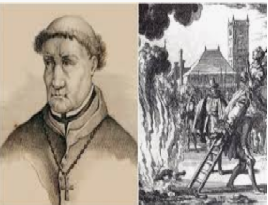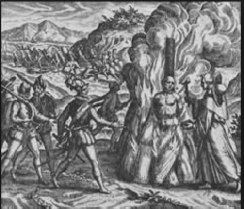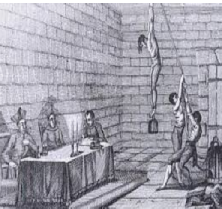|
PART 1 T O P I C |
|
|
|
|
|
|
|
|
|
|
|
|
|
|
|
|
|
|
|
CLICK BUTTON |
|
|
|
|
|
|
|
|
|
|
|
|
|
THE INQUISITION AND THE |
|
|
|
|
JewishWikipedia.info
The Inquisition came into existence through the actions of Pope Innocent III at the Fourth Lateran Council in 1215 and formally endorsed by Pope Gregory IX in 1233 creating the Dominicans and then the Franciscan's as Inquisitors. In 1260 a Papal Bull redirected their allegiance from their Orders to the Pope.
Inquisitors of all countries and ages followed the same body of canon law, gave the same punishments and used the same torture and devoted themselves to the same mission - the arrest, torture and execution of any man, woman or child they regarded as a heretic who excited their anxieties or greed. Middle Age manuals and handbooks, were still being used six centuries later.
Henry Lea, the overall authority on the Inquisition in summing up the verdict of history, states that “Fanatic zeal, arbitrary cruelty and insatiable cupidity rivaled each other in building up a system unspeakably atrocious. It was a standing mockery of justice - perhaps the most iniquitous that the arbitrary cruelty of man has ever devised.” (pp60,97)
‘Heresy’ comes from the Greek word for ‘choice’, so being a heretic is not from being accused of a crime but from having thoughts not allowed by the the church. This procedure was later described by George Orwell in his novel 1984 where he describes ‘thought crime’ as being guarded against by the ‘Thought Police’. As the dogma of the Church was still being developed it was impossible to know what was and was not allowed. Jonathan Kirsch in ‘The Grand Inquisitors Manual’ pp9 gives the following examples of why arrests were made
- Joan of Arc because she dressed in men's clothing (20 years later it became politically expedient for her to be retried. Her acquittal broke the authority of the Inquisition in France. In 1869 the Church began canonisation and in 1920 she was elevated to sainthood)
- Jewish and Muslim converts to Christianity who were accused of practising their previous religion in secret
- Galileo because he doubted the sun revolved round the earth. (His books remained on the Index till 1822 . In 1979 Pope John Paul II convened a commission to reconsider the verdict. After 13 years they said the Inquisition ‘had committed a subjective error of judgement‘. However his conviction on charges of heresy has never formally been reversed.)
- Doubt. The believer must have unwavering faith and it is the Inquisitor’s business to ascertain the condition of the waverers mind (Lea)
- A woman of North African descent seen to be eating couscous at a family meal.
- A Jewish convert to Catholicism seen to put on clean underwear on a Saturday
- A woman with a facial mole, a bad temper or no husband
- Living next door to someone whose supply of beer had gone bad
- Digging up corpses from a graveyard, then having them burnt and seizing assets from their descendents. This was often done where the ‘supply’ of heretics from other sources was running low
- Burning text such as the Jewish Talmud or of a Christian theologian whose author had long since died (this might be done for their image and/or to to seize assets from their descendents)
- Members of sects such as ‘The Free Spirits’
- Witches and worshipers of the Devil. As Norman Cohn said ‘it is far easier for one human being to torture another if he has convinced himself that the victim is not really human at all.’ (Europe’s Inner Demons 17, 20 adapted)
- Franciscans who attempted to uphold Francis' ideal of poverty were sometimes persecuted as heretics.
To justify their acts the Inquisition portrayed themselves as the ‘army of God fighting the traitors of God’ For example when announcing a sentence they let their imagination run wild by saying the individual had engaged in sexual orgies on behalf of Satan. For example a Spanish priest wrote of Muslim conversos that they were ‘the drones in the beehive, the ravens among the doves, the dogs in the Church, the gypsies among the Israelites and finally the heretics among the Catholics.’
The Inquisition operated on fear giving the impression of being omniscient and omnipresent so being a self contained power from whom no secret could be kept.
(FROM http://www.newworldencyclopedia.org/entry/Spanish_Inquisition)
Included under heretical propositions were verbal offenses, from outright blasphemy to questionable statements regarding religious beliefs, from issues of sexual morality, to behavior of the clergy. Many were brought to trial for affirming that simple fornication (sex without the explicit aim of procreation) was not a sin, or for doubting different aspects of Christian faith such as Transubstantiation or the virginity of Mary. Also, members of the clergy were sometimes accused of heresy.
OTHER OFFENCES
New World Encyclopedia
The Inquisition existed to combat heresy but it was also occupied with a wide variety of offenses only indirectly related to religious heterodoxy. Of a total of 49,092 trials from the period 1560–1700 registered in the archive of the Suprema, appear the following: judaizantes (5,007); moriscos (11,311); Lutherans (3,499); alumbrados (149); superstitions (3,750); heretical propositions (14,319); bigamy (2,790); solicitation (1,241); offenses against the Holy Office of the Inquisition (3,954); miscellaneous (2,575).
This data demonstrates that not only New Christians (conversos of Jewish or Islamic descent) and Protestants faced persecution, but also many Old Christians were targeted for various reasons.
The category "superstitions" includes trials related to witchcraft. The witch-hunt in Spain had much less intensity than in other European countries (particularly France, England, and Germany). One remarkable case was the case of Logroño, in which the witches of Zugarramurdi in Navarre were persecuted. During the Auto de Fe that took place in Logroño on November 7 and November 8, 1610, six people were burned and another five burned in effigy, which went down in history as the Basque witch trials. In general, nevertheless, the Inquisition maintained a skeptical attitude towards cases of witchcraft, considering it—in contrast to the Medieval Inquisitions—as a mere superstition without any basis. Alonso de Salazar Frias, who, after the trials of Logroño took the Edict of Faith to various parts of Navarre, a mountainous region inhabited by the Basque people, noted in his report to the Suprema that, "There were no witches nor bewitched in the region after beginning to speak and write about them"
Included under heretical propositions were verbal offenses, from outright blasphemy to questionable statements regarding religious beliefs, from issues of sexual morality, to behavior of the clergy. Many were brought to trial for affirming that simple fornication (sex without the explicit aim of procreation) was not a sin, or for doubting different aspects of Christian faith such as Transubstantiation or the virginity of Mary. Also, members of the clergy were sometimes accused of heresy.
The Inquisition also pursued offenses against morals, at times in open conflict with the jurisdictions of civil tribunals. In particular, there were numerous trials for bigamy, a relatively frequent offense in a society that only permitted divorce under the most extreme circumstances. In the case of men, the penalty was five years in the galley (tantamount to a death sentence). Women too were accused of bigamy. Also, many cases of solicitation during confession were adjudicated, indicating a strict vigilance over the clergy.
Homosexuality and bestiality, considered, according to Canon Law, crimes against nature, were also punished. Homosexuality, known at the time as sodomy, was punished by death by civil authorities. It fell under the jurisdiction of the Inquisition only in the territories of Aragon, when, in 1524, Clement VII, in a papal brief, granted jurisdiction over sodomy to the Inquisition of Aragon, whether or not it was related to heresy. In Castile, cases of sodomy were not adjudicated, unless related to heresy. The tribunal of Zaragoza distinguished itself for its severity in judging these offenses: between 1571 and 1579 more than 100 men accused of sodomy were processed and at least 36 were executed; in total, between 1570 and 1630 there were 534 trials and 102 executed.
In 1815, Francisco Xavier de Mier y Campillo, the Inquisitor General of the Spanish Inquisition and the Bishop of Almería, suppressed Freemasonry and denounced the lodges as “societies which lead to sedition, to independence, and to all errors and crimes.” He then instituted a purge during which Spaniards could be arrested on the charge of being “suspected of Freemasonry”.
THE
INCREDIBLE
STORY OF THE JEWISH PEOPLE



ACCUSATIONS made by the SPANISH INQUISITION
